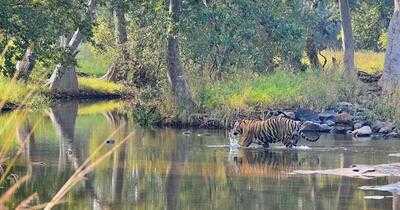

Tigers are often considered to be solitary creatures, prowling through the forest and defending their territories fiercely. But what happens when they are reintroduced into a new wild region where they have gone locally extinct? How do they interact when forced to share a new space?
“Since childhood, we have been taught that tigers do not exhibit group-living behaviour. However, the frequency and nature of their interactions, whether positive or antagonistic, have rarely been assessed quantitatively. Questions have remained about whether tigers possess a rudimentary social network or form weak, temporary social bonds,” says Supratim Dutta, research scholar at the Wildlife Institute of India.
To address this gap, Dutta and Ramesh Krishnamurthy, a scientist at the Wildlife Institute of India, conducted a
In the early 2000s, Panna’s tigers disappeared. Rampant poaching, poor protection, and mounting human pressures had wiped them out entirely. By 2009, it was clear that Panna Tiger Reserve needed drastic action. A reintroduction project began, and tigers from reserves such as Kanha and Pench were brought in to repopulate the area.

“The tiger in Panna...
-
Keir Starmer faces nightmare decision as Donald Trump approves Iran attack

-
Meghan Markle is all smiles as she poses for selfies hours after bombshell announcement

-
Ben Stokes Acknowledges Jasprit Bumrah's Threat Ahead of England Test Series

-
Stop! Don't Brush Again Until You Read This Comb Guide

-
Samantha Ruth Prabhu to Sobhita Dhulipala: When South Indian divas made a fashion case with contemporary sarees
